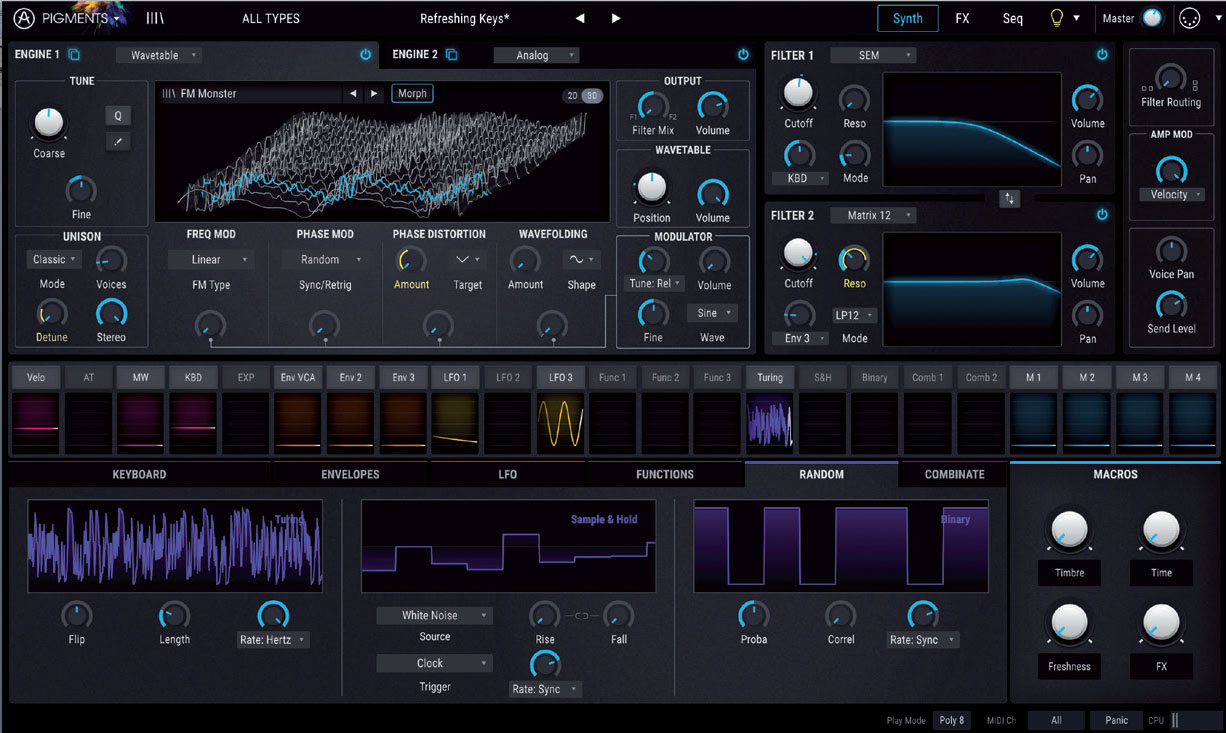
Price: €199 (£170) retail
Education discounts are available – contact your dealer arturia.com
I'll admit it. I have an obsession. No matter how many synthesiser plugins I have, I always seem to need another one. So, when Arturia announced the release of its latest product, Pigments, I was very excited. I make no secret about the fact that I like Arturia's products. I feel like the company is not well enough known for the quality of its products in the education market and that some of these products would enhance many music departments. You might think that I am being sponsored to say this me but I can assure that I am not – I have bought Pigments using money from my own pocket!
Arturia is best known for its suite of plugins that emulate classic synthesisers and electromechanical instruments, its MIDI controllers, its audio interfaces, and its excellent analogue synthesisers. However, while Pigments is something new for the company, it builds on much of Arturia's previous work in software design and synthesis. In fact, Arturia claims that Pigments contains 20 years of research and development. I'm reading this to mean that the company has been working on synthesis and software development over that period of time and that this is a combination of all of the different elements of its work, rather than the idea that it has been secretly working on this instrument for the past two decades.
Introduction
Pigments is, at its core, a software synthesiser but an incredibly powerful one. Pigments only has two oscillators but each one can either use wavetable synthesis or traditional analogue waveforms. If you aren't sure what wavetable synthesis is, this is when a synthesiser takes an audio sample of a recorded sound and uses a single wave of the recording as its oscillator. Most wavetable synthesisers can move the point of this wave to create an evolving or moving sound. It allows for significantly more complex sounds as the source material within your synthesiser.
One of the most complex tasks that often puts people off about programming synthesisers is the routing. This involves using one section of the synthesiser to control another, for instance using a low-frequency oscillator (LFO) to control the filter cutoff in order to achieve that 2012 dubstep wobble bass effect. With Pigments, however, Arturia has developed a very neat and simple method of linking different parameters together. Simply select the source element (LFO for instance) and it brings up a list of everything that it is currently controlling. Then simply click on the outline of the new parameter you want to control and they are linked together. This is cleverer than it sounds, and depending on how much you drag the mouse at the time of linking it changes the range of the control so the LFO will either sweep a little bit or a lot.
Alternatively, you can choose any control and instantly see what is routed to it. So, if you can hear something is changing but you aren't sure what, simply press the + that is to the top-right of any function and it will show what is controlling that parameter. I've never used a synth that was this quick to control this deeply.
The sounds
The important question you are now likely to be asking is: ‘How does it sound?’ And the answer is, quite simply, incredible. The sounds are complex and rich but at the same time musical. It has rich bass textures, usable pad sounds along with soaring lead lines. Using wavetable synthesis can have the potential to become gimmicky and create unnecessarily complex sounds for the sake of it. This has been the case in the past where the preset sounds in certain synthesisers sound amazing as demonstrations of the power of the synth but are totally unusable in a real-world musical context. This is not the case with Pigments. I haven't found a sound yet that I couldn't see myself using in the correct context, and with the ease of editing it would be easy to get any sound to where I want it to be very quickly.

The Pigments interface has lots of control and routing options available
Summary
Pigments is a powerful synthesiser and I can see why Arturia claims that it is the culmination of 20 years’ work. The combination of wavetable and analogue oscillators creates some beautiful textures that are still usable in a musical context, and the simplicity of routing make it surprisingly simple to operate despite the imposing interface. Therefore, if you are looking for an instrument to expand the sounds at your school, then Pigments would be a very sensible option. For GCSE music students looking to create EDM compositions, or KS5 music tech students with compulsory synthesis modules, this could be the perfect tool. I for one find the sounds inspiring, and it has made me want to start making some music – and frankly nothing could be more important in a piece of music equipment.








